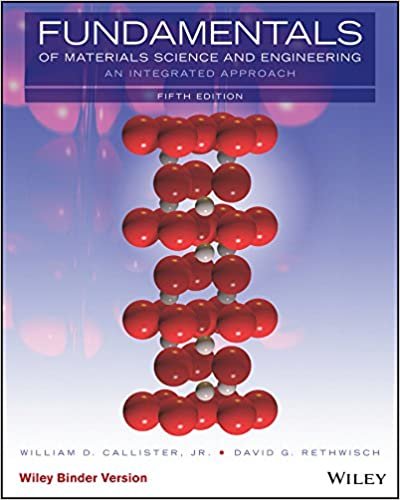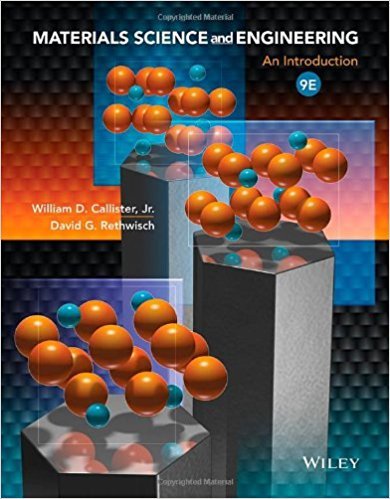Fundamentals of Materials Science and Engineering: An Integrated Approach 5th Edition, ISBN-13: 978-1119723677
Original price was: $50.00.$19.99Current price is: $19.99.
Fundamentals of Materials Science and Engineering: An Integrated Approach 5th Edition, ISBN-13: 978-1119723677
[PDF eBook eTextbook]
- Publisher: Wiley; 5th edition (July 28, 2020)
- Language: English
- 960 pages
- ISBN-10: 1119723671
- ISBN-13: 978-1119723677
Fundamentals of Materials Science and Engineering takes an integrated approach to the sequence of topics – one specific structure, characteristic, or property type is covered in turn for all three basic material types: metals, ceramics, and polymeric materials. This presentation permits the early introduction of non-metals and supports the engineer’s role in choosing materials based upon their characteristics. Using clear, concise terminology that is familiar to students, Fundamentals presents material at an appropriate level for both student comprehension and instructors who may not have a materials background.
Table of Contents:
List of Symbols xix
1. Introduction 1
Learning Objectives 2
1.1 Historical Perspective 2
1.2 Materials Science and Engineering 2
1.3 Why Study Materials Science and Engineering? 4
Case Study—Liberty Ship Failures 5
1.4 Classification of Materials 6
Case Study—Carbonated Beverage Containers 11
1.5 Advanced Materials 12
1.6 Modern Materials’ Needs 14
Summary 15
References 15
2. Atomic Structure and Interatomic Bonding 16
Learning Objectives 17
2.1 Introduction 17
Atomic Structure 17
2.2 Fundamental Concepts 17
2.3 Electrons in Atoms 19
2.4 The Periodic Table 25
Atomic Bonding in Solids 27
2.5 Bonding Forces and Energies 27
2.6 Primary Interatomic Bonds 29
2.7 Secondary Bonding or van der Waals Bonding 36
Materials of Importance—Water (Its Volume Expansion upon Freezing) 39
2.8 Mixed Bonding 40
2.9 Molecules 41
2.10 Bonding Type-Material Classification Correlations 41
Summary 42
Equation Summary 43
List of Symbols 43
Important Terms and Concepts 44
References 44
3. Structures of Metals and Ceramics 45
Learning Objectives 46
3.1 Introduction 46
Crystal Structures 46
3.2 Fundamental Concepts 46
3.3 Unit Cells 47
3.4 Metallic Crystal Structures 48
3.5 Density Computations—Metals 54
3.6 Ceramic Crystal Structures 54
3.7 Density Computations—Ceramics 60
3.8 Silicate Ceramics 61
3.9 Carbon 65
3.10 Polymorphism and Allotropy 66
3.11 Crystal Systems 66
Material of Importance—Tin (Its Allotropic Transformation) 68
Crystallographic Points, Directions, and Planes 69
3.12 Point Coordinates 69
3.13 Crystallographic Directions 72
3.14 Crystallographic Planes 78
3.15 Linear and Planar Densities 84
3.16 Close-Packed Crystal Structures 85
Crystalline and Noncrystalline Materials 89
3.17 Single Crystals 89
3.18 Polycrystalline Materials 89
3.19 Anisotropy 89
3.20 X-Ray Diffraction: Determination of Crystal Structures 91
3.21 Noncrystalline Solids 96
Summary 98
Equation Summary 100
List of Symbols 101
Important Terms and Concepts 102
References 102
4. Polymer Structures 103
Learning Objectives 104
4.1 Introduction 104
4.2 Hydrocarbon Molecules 104
4.3 Polymer Molecules 107
4.4 The Chemistry of Polymer Molecules 107
4.5 Molecular Weight 111
4.6 Molecular Shape 114
4.7 Molecular Structure 116
4.8 Molecular Configurations 117
4.9 Thermoplastic and Thermosetting Polymers 120
4.10 Copolymers 121
4.11 Polymer Crystallinity 122
4.12 Polymer Crystals 126
Summary 128
Equation Summary 129
List of Symbols 130
Important Terms and Concepts 130
References 130
5. Imperfections in Solids 131
Learning Objectives 132
5.1 Introduction 132
Point Defects 133
5.2 Point Defects in Metals 133
5.3 Point Defects in Ceramics 134
5.4 Impurities in Solids 137
5.5 Point Defects in Polymers 142
5.6 Specification of Composition 142
Miscellaneous Imperfections 146
5.7 Dislocations—Linear Defects 146
5.8 Interfacial Defects 149
5.9 Bulk or Volume Defects 152
5.10 Atomic Vibrations 152
Materials of Importance—Catalysts (and Surface Defects) 153
Microscopic Examination 154
5.11 Basic Concepts of Microscopy 154
5.12 Microscopic Techniques 155
5.13 Grain-Size Determination 159
Summary 162
Equation Summary 164
List of Symbols 165
Important Terms and Concepts 165
References 165
6. Diffusion 166
Learning Objectives 167
6.1 Introduction 167
6.2 Diffusion Mechanisms 168
6.3 Fick’s First Law 169
6.4 Fick’s Second Law—Nonsteady-State Diffusion 171
6.5 Factors that Influence Diffusion 175
6.6 Diffusion in Semiconducting Materials 180
Materials of Importance—Aluminum for Integrated Circuit Interconnects 183
6.7 Other Diffusion Paths 184
6.8 Diffusion in Ionic and Polymeric Materials 184
Summary 187
Equation Summary 188
List of Symbols 189
Important Terms and Concepts 189
References 189
7. Mechanical Properties 190
Learning Objectives 191
7.1 Introduction 191
7.2 Concepts of Stress and Strain 192
Elastic Deformation 196
7.3 Stress–Strain Behavior 196
7.4 Anelasticity 199
7.5 Elastic Properties of Materials 200
Mechanical Behavior—Metals 202
7.6 Tensile Properties 203
7.7 True Stress and Strain 210
7.8 Elastic Recovery after Plastic Deformation 213
7.9 Compressive, Shear, and Torsional Deformations 213
Mechanical Behavior—Ceramics 214
7.10 Flexural Strength 214
7.11 Elastic Behavior 215
7.12 Influence of Porosity on the Mechanical Properties of Ceramics 215
Mechanical Behavior—Polymers 217
7.13 Stress–Strain Behavior 217
7.14 Macroscopic Deformation 219
7.15 Viscoelastic Deformation 220
Hardness and Other Mechanical Property Considerations 224
7.16 Hardness 224
7.17 Hardness of Ceramic Materials 229
7.18 Tear Strength and Hardness of Polymers 230
Property Variability and Design/Safety Factors 231
7.19 Variability of Material Properties 231
7.20 Design/Safety Factors 233
Summary 237
Equation Summary 239
List of Symbols 240
Important Terms and Concepts 241
References 241
8. Deformation and Strengthening Mechanisms 243
Learning Objectives 244
8.1 Introduction 244
Deformation Mechanisms For Metals 244
8.2 Historical 245
8.3 Basic Concepts of Dislocations 245
8.4 Characteristics of Dislocations 247
8.5 Slip Systems 248
8.6 Slip in Single Crystals 250
8.7 Plastic Deformation of Polycrystalline Metals 253
8.8 Deformation by Twinning 255
Mechanisms of Strengthening in Metals 256
8.9 Strengthening by Grain Size Reduction 256
8.10 Solid-Solution Strengthening 258
8.11 Strain Hardening 259
Recovery, Recrystallization, and Grain Growth 262
8.12 Recovery 262
8.13 Recrystallization 263
8.14 Grain Growth 267
Deformation Mechanisms For Ceramic Materials 269
8.15 Crystalline Ceramics 269
8.16 Noncrystalline Ceramics 269
Mechanisms of Deformation and For Strengthening of Polymers 270
8.17 Deformation of Semicrystalline Polymers 270
8.18 Factors that Influence the Mechanical Properties of Semicrystalline Polymers 272
Materials of Importance—Shrink-Wrap Polymer Films 275
8.19 Deformation of Elastomers 276
Summary 278
Equation Summary 281
List of Symbols 281
Important Terms and Concepts 281
References 282
9. Failure 283
Learning Objectives 284
9.1 Introduction 284
Fracture 285
9.2 Fundamentals of Fracture 285
9.3 Ductile Fracture 285
9.4 Brittle Fracture 287
9.5 Principles of Fracture Mechanics 289
9.6 Brittle Fracture of Ceramics 298
9.7 Fracture of Polymers 302
9.8 Fracture Toughness Testing 304
Fatigue 308
9.9 Cyclic Stresses 309
9.10 The S–N Curve 310
9.11 Fatigue in Polymeric Materials 315
9.12 Crack Initiation and Propagation 316
9.13 Factors that Affect Fatigue Life 318
9.14 Environmental Effects 320
Creep 321
9.15 Generalized Creep Behavior 321
9.16 Stress and Temperature Effects 322
9.17 Data Extrapolation Methods 325
9.18 Alloys for High-Temperature Use 326
9.19 Creep in Ceramic and Polymeric Materials 327
Summary 327
Equation Summary 330
List of Symbols 331
Important Terms and Concepts 332
References 332
10. Phase Diagrams 333
Learning Objectives 334
10.1 Introduction 334
Definitions and Basic Concepts 334
10.2 Solubility Limit 335
10.3 Phases 336
10.4 Microstructure 336
10.5 Phase Equilibria 336
10.6 One-Component (or Unary) Phase Diagrams 337
Binary Phase Diagrams 338
10.7 Binary Isomorphous Systems 339
10.8 Interpretation of Phase Diagrams 341
10.9 Development of Microstructure in Isomorphous Alloys 345
10.10 Mechanical Properties of Isomorphous Alloys 348
10.11 Binary Eutectic Systems 348
10.12 Development of Microstructure in Eutectic Alloys 354
Materials of Importance—Lead-Free Solders 355
10.13 Equilibrium Diagrams Having Intermediate Phases or Compounds 361
10.14 Eutectoid and Peritectic Reactions 364
10.15 Congruent Phase Transformations 365
10.16 Ceramic Phase Diagrams 365
10.17 Ternary Phase Diagrams 369
10.18 The Gibbs Phase Rule 370
The Iron–Carbon System 372
10.19 The Iron–Iron Carbide (Fe–Fe3C) Phase Diagram 372
10.20 Development of Microstructure in Iron–Carbon Alloys 375
10.21 The Influence of Other Alloying Elements 382
Summary 383
Equation Summary 385
List of Symbols 386
Important Terms and Concepts 386
References 386
11. Phase Transformations 387
Learning Objectives 388
11.1 Introduction 388
Phase Transformations in Metals 388
11.2 Basic Concepts 389
11.3 The Kinetics of Phase Transformations 389
11.4 Metastable Versus Equilibrium States 400
Microstructural and Property Changes in Iron–Carbon Alloys 401
11.5 Isothermal Transformation Diagrams 401
11.6 Continuous-Cooling Transformation Diagrams 412
11.7 Mechanical Behavior of Iron–Carbon Alloys 415
11.8 Tempered Martensite 419
11.9 Review of Phase Transformations and Mechanical Properties for Iron–Carbon Alloys 422
Materials of Importance—Shape-Memory Alloys 425
Precipitation Hardening 428
11.10 Heat Treatments 428
11.11 Mechanism of Hardening 430
11.12 Miscellaneous Considerations 432
Crystallization, Melting, and Glass Transition Phenomena in Polymers 433
11.13 Crystallization 433
11.14 Melting 434
11.15 The Glass Transition 434
11.16 Melting and Glass Transition Temperatures 435
11.17 Factors that Influence Melting and Glass Transition Temperatures 435
Summary 438
Equation Summary 440
List of Symbols 441
Important Terms and Concepts 441
References 441
12. Electrical Properties 442
Learning Objectives 443
12.1 Introduction 443
Electrical Conduction 443
12.2 Ohm’s Law 443
12.3 Electrical Conductivity 444
12.4 Electronic and Ionic Conduction 445
12.5 Energy Band Structures in Solids 445
12.6 Conduction in Terms of Band and Atomic Bonding Models 447
12.7 Electron Mobility 449
12.8 Electrical Resistivity of Metals 450
12.9 Electrical Characteristics of Commercial Alloys 453
Materials of Importance—Aluminum Electrical Wires 453
Semiconductivity 455
12.10 Intrinsic Semiconduction 455
12.11 Extrinsic Semiconduction 458
12.12 The Temperature Dependence of Carrier Concentration 461
12.13 Factors that Affect Carrier Mobility 462
12.14 The Hall Effect 466
12.15 Semiconductor Devices 468
Electrical Conduction in Ionic Ceramics and in Polymers 474
12.16 Conduction in Ionic Materials 475
12.17 Electrical Properties of Polymers 475
Dielectric Behavior 476
12.18 Capacitance 476
12.19 Field Vectors and Polarization 478
12.20 Types of Polarization 481
12.21 Frequency Dependence of the Dielectric Constant 483
12.22 Dielectric Strength 484
12.23 Dielectric Materials 484
Other Electrical Characteristics of Materials 484
12.24 Ferroelectricity 484
12.25 Piezoelectricity 485
Material of Importance—Piezoelectric Ceramic Ink-Jet Printer Heads 486
Summary 487
Equation Summary 490
List of Symbols 490
Important Terms and Concepts 491
References 491
13. Types and Applications of Materials 492
Learning Objectives 493
13.1 Introduction 493
Types of Metal Alloys 493
13.2 Ferrous Alloys 493
13.3 Nonferrous Alloys 506
Materials of Importance—Metal Alloys Used for Euro Coins 516
Types of Ceramics 517
13.4 Glasses 518
13.5 Glass-Ceramics 518
13.6 Clay Products 520
13.7 Refractories 520
13.8 Abrasives 523
13.9 Cements 525
13.10 Carbons 526
13.11 Advanced Ceramics 528
Types of Polymers 533
13.12 Plastics 533
Materials of Importance—Phenolic Billiard Balls 536
13.13 Elastomers 536
13.14 Fibers 538
13.15 Miscellaneous Applications 539
13.16 Advanced Polymeric Materials 540
Summary 544
Important Terms and Concepts 547
References 547
14. Synthesis, Fabrication, and Processing of Materials 548
Learning Objectives 549
14.1 Introduction 549
Fabrication of Metals 549
14.2 Forming Operations 550
14.3 Casting 551
14.4 Miscellaneous Techniques 553
Thermal Processing of Metals 554
14.5 Annealing Processes 554
14.6 Heat Treatment of Steels 557
Fabrication of Ceramic Materials 566
14.7 Fabrication and Processing of Glasses and Glass-Ceramics 568
14.8 Fabrication and Processing of Clay Products 573
14.9 Powder Pressing 577
14.10 Tape Casting 579
Synthesis and Fabrication of Polymers 580
14.11 Polymerization 580
14.12 Polymer Additives 583
14.13 Forming Techniques for Plastics 584
14.14 Fabrication of Elastomers 587






Reviews
There are no reviews yet.